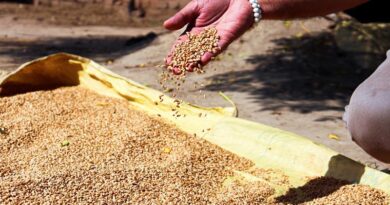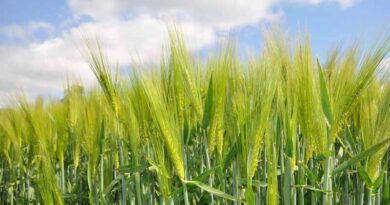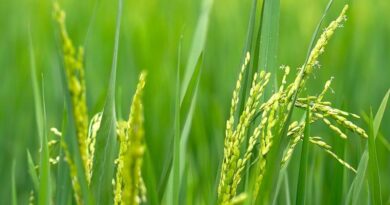Weed Management in Wheat Crop
15 December 2021, New Delhi: Wheat is the second most important crop for food grains in India after rice. Its maximum consumption happens in the north and north-western part of India. After independence, the yield of wheat in India was only 663 kg/ha, due to which wheat was imported from abroad. After the Green Revolution i.e. in 1960, with the advent of progressive wheat varieties, India progressively became self-sufficient in wheat. Today, India is ranks second after China in the world by producing 870 lakh tonnes. At present, the yield stands at 3,533 kg/ha.
In India, Uttar Pradesh is at the first position with the highest yield of 252.2 lakh tonnes followed by Punjab with 157.8 lakh tonnes and Madhya Pradesh with 141.8 lakh tonnes. As far as the productivity is concerned, Uttar Pradesh being the largest area, its productivity is 3432 kg / ha which is below the national standard. Punjab has the productivity with 5188 kg / ha.
State-wise Wheat Area and Productivity
| State | Area (LakhHa) 2019-2020* | Area (Lakh Ha) 2018-19 | Productivity (kg/ha) 2019-2020* | Productivity (kg/ha) 2018-19 |
| Uttar Pradesh | 95.0 | 95.4 | 3432 | 3432 |
| Madhya Pradesh | 65.5 | 55.2 | 2993 | 2993 |
| Punjab | 35.1 | 35.2 | 5008 | 5188 |
| Haryana | 25.3 | 25.5 | 4687 | 4925 |
| Rajasthan | 31.2 | 28.8 | 3501 | 3501 |
| Bihar | 22.5 | 21.6 | 2626 | 2998 |
| Gujarat | 10.2 | 8.0 | 3155 | 3020 |
| Maharashtra | 12.5 | 8.3 | 1657 | 1497 |
| Uttarakhand | 3.2 | 3.3 | 2889 | 2910 |
| West Bengal | 1.9 | 1.1 | 3100 | 3012 |
| Others | 12.2 | 10.8 | 1927 | 1858 |
| Total | 314.5 | 293.2 | 3421 | 3533 |
The yield of crop depends on crop protection which includes controlling biotic factors. Weed management and disease and pest management are the main biological factors. Here we will discuss about weed management.
Mandusi or Gulli Danda (Phalaris minor) weed is the main weed of wheat crop. If not controlled in time, it may go upto 2000 to 3000 tillers in one square meter and the farmer will have to use his crop as fodder. In the 1980s, Isoproturon continued to be used for the control of this weed, but in later years Phalaris minor became resistant to this weedicide.
Three ways to control weeds in wheat crop
- Inter cultivation practices
- Mechanical Control
- Chemical Control
In this research article, an attempt has been made to give some necessary suggestions/information regarding the use of weedicides by the farmers.
Weedicide can be used in wheat in two ways:-
Pre-emergence (pre-emergence)
Weeds when two to four leaves (post-emergence)
Before crop and weed establishment (pre-emergence):
The growing weeds can be destroyed by sprinkling of pendimethylene @ 3.3 liters per hectare in 500 liters of water immediately after sowing of wheat.
When weeds are in two to four leaves (post-emergence):
Use of post-emergence weedicide in wheat should be done 7 to 10 days after the first irrigation (21 days after sowing) when the fields are established and the weeds are in 2 to 4 leaf stage.
Use of weedicide chemicals in wheat:
| Weedicide | Quantity/hectare | Timeofapplication | TypeofWeed |
| Metsulfuron methyl | 20 Grams | 35-40 days after sowing | Broad Leaf |
| Carfentrazone 40% df (nabood) | 50 Grams | 35-40 days after sowing | Broad Leaf |
| Vidmar Super (2,4-D Amine Salt 58% SL) | 860 to 1290 ml | 35-40 days after sowing | Broad Leaf |
| Sulfosulfuron | 33.3 Grams | 35-40 days after sowing | Broad and Narrow leaf |
| Barrier (Metribuzin 70% WP) | 250 Grams | Before sowing or just after sowing | Broad and Narrow leaf |
| Clodinofop Propergyl 15% WP (dynohop) | 400 Grams | 35-40 days after sowing | Narrow Leaf |
| Pinoxadene (Fenox-1000) | 800-900 ml | 35-40 days after sowing | Narrow Leaf |
Precautions:
- Use chemical weedicides when there is sufficient moisture in the soil.
- Use post-emergence weedicide only when weedicide is in 2 to 4 leaf stage.
- Spraying of any weedicide should be done only in the state of soil moisture.
- Spray at 2-3 leaf stage of Mandusi, otherwise favorable results will not be obtained.
- Spray with flat fan/flood jet nozzle in clear weather.
- Spray weedicides evenly.
- Never spray Sulfosulfuron in the field in which any other crop is being grown.
Seed Treatment of Wheat
Before sowing of wheat, seed treatment of wheat is very important from the point of view of production. Vitavex Ultra is a great fungicide for this, it contains two powerful fungicides, Carboxin and Thiram. With its treatment, seeds can be saved from many types of fungal diseases and high production can be obtained with good germination.
80-120 ml Fungicide is dissolved in 200 l water. The medicine mixture must be sprinkled evenly on about 40 kg seed. The seeds are dried by keeping them in the shade.














